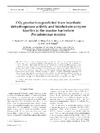Identificador persistente para citar o vincular este elemento:
https://accedacris.ulpgc.es/jspui/handle/10553/50865
| Campo DC | Valor | idioma |
|---|---|---|
| dc.contributor.author | Packard, T. | en_US |
| dc.contributor.author | Berdalet, E. | en_US |
| dc.contributor.author | Blasco, D. | en_US |
| dc.contributor.author | Roy, S. O. | en_US |
| dc.contributor.author | St-Amand, L. | en_US |
| dc.contributor.author | Lagacé, B. | en_US |
| dc.contributor.author | Lee, K. | en_US |
| dc.contributor.author | Gagné, J. P. | en_US |
| dc.date.accessioned | 2018-11-24T19:29:12Z | - |
| dc.date.available | 2018-11-24T19:29:12Z | - |
| dc.date.issued | 1996 | en_US |
| dc.identifier.issn | 0948-3055 | en_US |
| dc.identifier.uri | https://accedacris.ulpgc.es/handle/10553/50865 | - |
| dc.description.abstract | CO2 production in aerobic bacteria was modeled from the time-courses of the in vitro activity of isocitrate dehydrogenase (IDH), bacterial protein, and the concentration of the carbon source in the cultures. The model was based on the concept of bisubstrate control of the IDH reaction throughout the exponential, steady-state, and senescent phases of the cultures. In the exponential phase, the measured rates of CO2 production and the in vitro IDH activity were closely coupled, but in the senescent phase, they became uncoupled. The in vitro IDH activity remained high even after the culture's carbon source was exhausted, while the CO2 production fell to low levels. Based on the hypothesis that this uncoupling was caused by internal substrate limitation, 2 mathematical models incorporating a bisubstrate enzyme kinetics algorithm were constructed and tested. The models predicted the rate of CO2 production throughout the different phases of the cultures with an r2 greater than 0.84. | en_US |
| dc.language | eng | en_US |
| dc.publisher | 0948-3055 | |
| dc.relation.ispartof | Aquatic Microbial Ecology | en_US |
| dc.source | Aquatic Microbial Ecology [ISSN 0948-3055], v. 11, p. 11-19 | en_US |
| dc.subject | 230331 Química del agua | en_US |
| dc.subject | 2302 Bioquímica | en_US |
| dc.subject.other | Respiration | en_US |
| dc.subject.other | Metabolism | en_US |
| dc.subject.other | Bacteria | en_US |
| dc.subject.other | Carbon dioxide | en_US |
| dc.subject.other | Ocean model | en_US |
| dc.subject.other | Isocitrate dehydrogenase activity | en_US |
| dc.title | CO2 production predicted from isocitrate dehydrogenase activity and bisubstrate enzyme kinetics in the marine bacterium Pseudomonas nautica | en_US |
| dc.type | info:eu-repo/semantics/article | en_US |
| dc.type | Article | en_US |
| dc.identifier.doi | 10.3354/ame011011 | en_US |
| dc.identifier.scopus | 0002214859 | - |
| dc.contributor.authorscopusid | 7004249480 | - |
| dc.contributor.authorscopusid | 55975291500 | - |
| dc.contributor.authorscopusid | 35565093700 | - |
| dc.contributor.authorscopusid | 8923658500 | - |
| dc.contributor.authorscopusid | 56636766200 | - |
| dc.contributor.authorscopusid | 6506671016 | - |
| dc.contributor.authorscopusid | 57203464470 | - |
| dc.contributor.authorscopusid | 57200973311 | - |
| dc.description.lastpage | 19 | - |
| dc.description.firstpage | 11 | - |
| dc.relation.volume | 11 | - |
| dc.investigacion | Ciencias | en_US |
| dc.type2 | Artículo | en_US |
| dc.utils.revision | Sí | en_US |
| dc.identifier.ulpgc | Sí | es |
| dc.description.scie | SCIE | |
| item.fulltext | Con texto completo | - |
| item.grantfulltext | open | - |
| crisitem.author.dept | GIR ECOAQUA: Ecofisiología de Organismos Marinos | - |
| crisitem.author.dept | IU de Investigación en Acuicultura Sostenible y Ec | - |
| crisitem.author.orcid | 0000-0002-5880-1199 | - |
| crisitem.author.parentorg | IU de Investigación en Acuicultura Sostenible y Ec | - |
| crisitem.author.fullName | Packard, Theodore Train | - |
| Colección: | Artículos | |
Los elementos en ULPGC accedaCRIS están protegidos por derechos de autor con todos los derechos reservados, a menos que se indique lo contrario.
